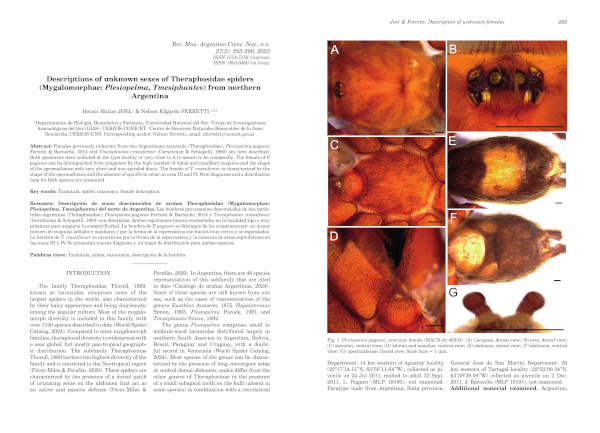Descriptions of undescribed sexes of Theraphosidae spiders (Mygalomorphae: Plseiopelma, Tmesiphantes) from northern Argentina
Resumen
Females previously unknown from two Argentinean tarantula (Theraphosidae), Plesiopelma paganoi Ferretti & Barneche, 2014 and Tmesiphantes crassifemur (Gerschman & Schiapelli, 1960) are described for the first time. Both specimens were collected at the type locality or very close to it to assure to be conspecific. The female of P. paganoi can be distinguished from congeners by the high number of labial and maxillary cuspules and the shape of the spermathecae with very short and non-spiraled ducts. The female of T. crassifemur is characterized by the shape of the spermathecae and the absence of spiniform setae on coxa III and IV. New diagnosis are presented and a distribution map of both species.Descargas
Referencias
Allegue, M., Nicoletta, M., Panchuk, J., Schwerdt, L. & N. Ferretti. 2023. New record of Plesiopelma aspidosperma and distribution extension of Cyriocosmus versicolor (Araneae: Theraphosidae) from Argentina. Munis Entomology and Zoology 18: 1846–1853.
Bond, J.E. 2012. Phylogenetic treatment and taxonomic revision of the trapdoor spider genus Aptostichus Simon (Araneae, Mygalomorphae, Euctenizidae). Zookeys 252: 1–209.
Catálogo de Arañas de Argentina. 2024. Catálogo de Arañas de Argentina. Museo Argentino de Ciencias Naturales "Bernardino Rivadavia". Retrieved from https://sites.google.com/site/catalogodearanasdeargentina/. Accesed September 24, 2024.
Coyle, F.A. 1995. A revision of the funnel web mygalomorph spider subfamily Ischnothelinae (Araneae, Dipluridae). Bulletin of the American Museum of Natural History 226: 1–133.
Fabiano-da-Silva, W., J.P.L. Guadanucci & M.B. DaSilva. 2019. Taxonomy and phylogenetics of Tmesiphantes Simon, 1892 (Araneae, Theraphosidae). Systematics and Biodiversity 17(7): 650–668.
Ferretti, N. & J. Barneche. 2014. Description of two new species of Plesiopelma (Araneae, Theraphosidae, Theraphosinae) from Argentina. Iheringia, Série Zoologia 103(4, 2013): 374–380.
Ferretti, N., Nicoletta, M. & D.S. Soresi. 2024. An integrative taxonomy approach evaluates the limits of the widespread tarantula Plesiopelma longisternale (Araneae: Mygalomorphae: Theraphosidae) and reveals a new species from Argentina. Zoologischer Anzeiger 308: 131–143.
Gerschman de P., B. S. & R.D. Schiapelli. 1960. Un nuevo género con una nueva especie de Ischnocolinae (Araneae-Theraphosidae). Physis, Revista de la Sociedad Argentina de Ciencias Naturales (C) 21: 200–206.
Lucas, S. & W. Bücherl. 1973. Revision von Typenmaterial der Vogelspinnensammlung des Institutes Butantan. Zoologischer Anzeiger 190: 237–250.
Perafán, R. & F. Pérez-Miles. 2014. Three new species of Melloleitaoina Gerschman and Schiapelli, 1960 (Araneae, Mygalomorphae, Theraphosidae) from northern Argentina. ZooKeys 404: 117–129.
Pérez-Miles, F. Lucas, S.M., Silva, J.P.I & R. Bertani. 1996. Systematic revision and cladistic analysis of Theraphosinae (Araneae: Theraphosidae). Mygalomorph 1: 33–68.
Petrunkevitch, A. 1925. Arachnida from Panama. Transactions of the Connecticut Academy of Arts and Sciences 27: 51–248.
World Spider Catalog. 2024. World Spider Catalog. Version 25.5. Natural History Museum Bern. Retrieved at http://wsc.nmbe.ch. Accessed on September 25, 2024.
Yamamoto, F.U., Lucas, S.M., Guadanucci, J.P.L. & R.P. Indicatti. 2007. Revision of the genus Tmesiphantes Simon (Araneae, Mygalomorphae, Theraphosidae). Revista Brasileira de Zoologia 24: 971–980.

Descargas
Publicado
Número
Sección
Licencia
Los autores/as que publiquen en esta revista aceptan las siguientes condiciones:- Los autores/as conservan los derechos de autor y ceden a la revista el derecho de la primera publicación, con el trabajo registrado con la licencia de atribución de Creative Commons, que permite a terceros utilizar lo publicado siempre que mencionen la autoría del trabajo y a la primera publicación en esta revista.
- Se permite y recomienda a los autores/as a publicar su trabajo en Internet (por ejemplo en páginas institucionales o personales), ya que puede conducir a a una mayor y más rápida difusión del trabajo publicado.
